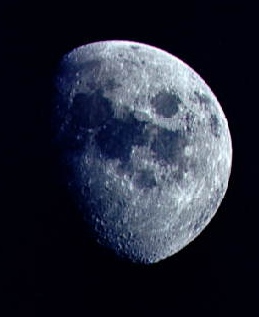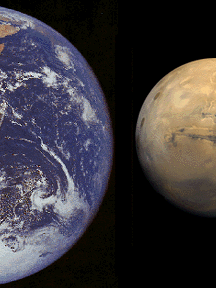This drawing shows how individual molecules may move near the surface of the Moon to form an atmosphere.
NASA
The Lunar Atmosphere
People used to think that moons such as the Earth's moon had no atmosphere whatsoever. Now, however, measurements have shown that most of these moons are surrounded by a *very* thin region of molecules which can *almost* be called an atmosphere. Such is the case with the Moon.
The atmosphere may come from a couple of places, one place is
outgassing or the release of gases from deep within the Moon's
interior.
Another source, as shown in this diagram, are molecules which are loosened from the surface when other molecules from space hit the ground. These molecules may migrate across the surface of the Moon, to colder regions where they re-freeze into the ground. Or they may fly off into space. This is one way lunar water may be formed.
Molecules from space come from the solar wind. Because its surface is
protected by neither an atmosphere nor a magnetosphere, the Moon is constantly
exposed to the solar wind. These molecules get buried in the Moon's surface. Eventually scientists on Earth will understand more about a process, called nuclear fusion, which is another way create energy. Then these molecules buried in the Moon's surface may become an important source of fuel for energy.
You might also be interested in:

How did life evolve on Earth? The answer to this question can help us understand our past and prepare for our future. Although evolution provides credible and reliable answers, polls show that many people turn away from science, seeking other explanations with which they are more comfortable.
...more
The atmosphere of the Moon may come from a couple of sources, one source is outgassing which means gases coming from deep within the Moon. Gases are released from the interior of the Moon during moonquakes.
...more
In the past everyone thought that the Moon had no water. Moon rocks found by Apollo astronauts contained no traces of water. Lunar mapping performed by the Galileo spacecraft, shown here, found no traces
...more
The Earth may only have one Moon, but it's a big one! The Earth's Moon is the fifth largest in the whole solar system. But it is still smaller than the Earth, so objects weigh less on the Moon than they
...more
Any successful theory must account for everything we know about the Moon now. Those things include the moon seems to be made of the same material as the Earth's upper mantle. the Moon has little or no
...more
Although the Moon does not appear to have a magnetosphere surrounding it, it *is* a magnetic object in space. Scientists think that the magnetism of the Moon's surface is leftover from a time when the
...more
Any successful theory must account for everything we know about the Moon now, as well as make predictions about future observations. There are three theories about how the moon came to be in place: that
...more
Here's a safe and easy way to make lightning. You will need a cotton or wool blanket. This experiment works best on a dry, cool night. Turn out all the lights and let your eyes adjust to the darkness.
...more












